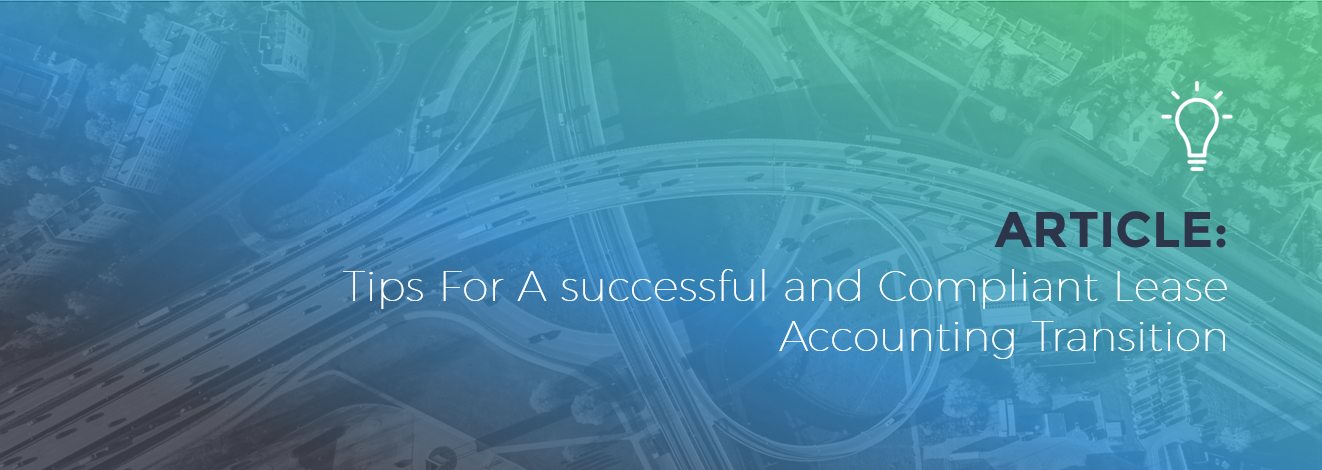Tips For A successful and Compliant Lease Accounting Transition
Updated 18th May 2021 | 5 min read Published 22nd June 2018

Overview: What does the new lease accounting standard entail?
After more than a decade of planning, debate, consultation and definition, the International Accounting Standards Board (IASB) and their counterpart in the United States, the Financial Accounting Standards Board (FASB) have together redefined for lessees the classification and reporting of leases and their financial impact. Though there are differences, essentially both IFRS 16 and ASC 842 have the same lease accounting rules, definitions and aims. And pretty much the same deadlines for implementation - 2019 is late!
Whether leasing real estate or more mobile assets the changes apply to your business. Awareness of the challenge of transition and implications of compliance are essential.
The aim of IFRS 16/ASC 842, the new lease accounting rules, has been to verify the quality and comparability of financial reporting by providing greater transparency about leverage, the assets an entity uses in its operations, and the risks to which it is exposed from entering into lease transactions.
Under the former guidelines, any lease agreement which did not qualify as a finance lease—where the risks and rewards of ownership are effectively transferred to the lessee — need not be included as a liability or asset on the balance sheet – a practice open to abuse and potentially leading to misinformation.
ASC 842 and its equivalent IFRS 16 will require organisations that lease assets to recognise on their balance sheet the assets and liabilities for the rights and obligations created by those leases.
Simply put, the revised lease accounting rules dictate that businesses, public or private, will no longer be able to account for operating leases as being “off balance sheet”. Transparency is the target and the inclusion of all right of use assets, together with their associated liabilities, on the balance sheet will improve representation and comparability of performance and financial stability.
The experience and awareness of those companies which have already begun the transition to the new lease accounting standard, together with the expertise of specialist “leasing” consultancies and advisers evidence that there are a number of areas that need particular attention and the lease accounting transition tips below which we at Innervision have identified as key will be relevant to all those embarking on the challenge of on-time compliance with IFRS 16/ASC 842 – whether the leases involve real estate or moveable assets.
1. You Are Not Alone
Speak with your auditors and engage the expertise of advisers in the leasing sector. These firms, such as Innervision understand the resource, time and expense that will be needed to attain compliance. They may already be familiar with your business or even your lease portfolio. They will certainly have managed the transition to compliance for a similar business and are well placed to advise you on crucial accounting decisions. Under the new lease accounting standards, certain accounting policy elections (practical expedients) and judgement exist that lessees will have to consider when applying the new standards. It is important to seek out the advice and guidance of your auditor when making these decisions, as the choice you make may have significant implications on your financial statements. They will be also able to assure you that compliance is achievable in time for the deadline. Meet with them now.
2. Others Are Interested
If your business currently leases assets or real estate then the financial metrics of your business will almost certainly change with the implementation of IFRS 16/ASC 842. People, and that includes stakeholders in the business, do not like surprises – particularly where they have a financial interest. Keep everyone informed (shareholders, lenders, lessors, creditors, management and the board), prepare comparative financials, regularly present progress and keep them up to date! Awareness by all parties of what is faced by transition and what is needed for compliance will lead to a supported project.
3. Embrace Technology
You will have an internal resource in the form of manpower, but does that resource really have the time to fully engage with a lease accounting compliance project. Is the expertise required readily available in the business? Who should be leading the project? If you have a portfolio of leases, then you will need to not only make the accounting for the same compliant, but you will also want a solution that makes the management of the portfolio and its assets more robust and less in the hands of lessors going forward. Software-led solutions are available – forget spreadsheets! The use of spreadsheets is one reason your business is where it is with regard to lease management. Your IT department may be a good resource to identify, test and analyse web-based applications such as Innervision’s class-leading “Lois Lease Accounting“- (LLA).
4. Act Now
With just months left (at the time of writing) to the compliance deadline it is essential that you take action now. December 2018 for ASC 842 and January 2019 are key days to be met. The standards are straightforward, understandable and deliverable on as you go forward but the complexities lie in identifying, reclassifying and reassessing your existing lease portfolio. The entries to your general ledger, the collation of the data, the comparative accounting reports are best addressed by engaging with a technological solution and time is running out for not only implementation of such a solution but even identification of one!
5. Keep It Simple
The clock is ticking, stakeholders are watching, the lease portfolio needs collating, the financial journals need raising, expertise needs to be found and engaged! Lack of time, expertise and resource dictate that a technological solution will be your answer and so you need to find one. That solution should be cloud-based, web-enabled, secure, tested, live (and by that we mean available today) and ideally be able to collate, analyse and report – there are such solutions available and LLA from Innervision is one that ticks all those boxes but additionally generates journal entries for your ledgers, manages new leases as well as old and handles IFRS 16 as well as ASC 842. Can the data and reports be accessible to all interested parties wherever they are located? Are there access levels?
This piece has been written to draw to your attention the need right now for awareness, action, openness, simplicity, technology and decision. To learn more about Innervision’s Lois Lease Accounting LLA solution then click on the link below.







